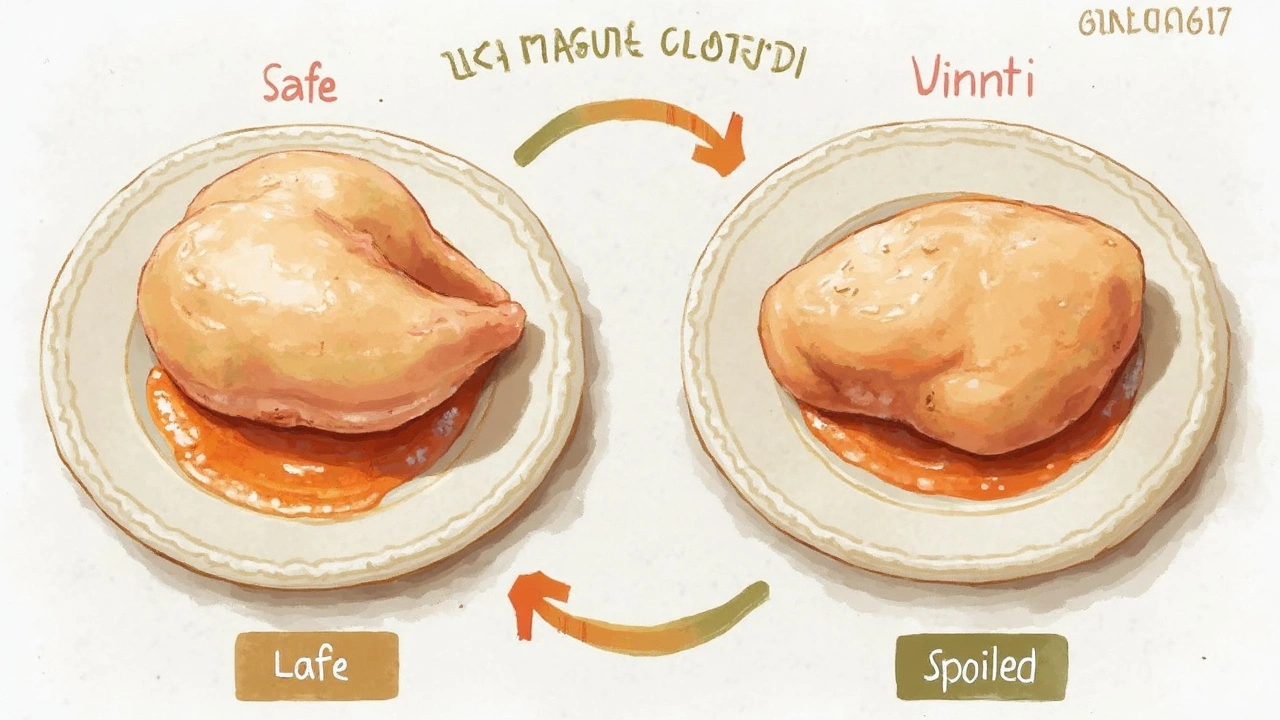Chicken Pooping Liquid: What Home Cooks Need to Know
 May, 2 2025
May, 2 2025
You open a pack of chicken for tandoori night and bam—there's a puddle of weird, watery stuff at the bottom. Maybe it even looks a bit gross and makes you wonder if your chicken is safe to use. Before you freak out, let’s clear something up right away: that liquid isn’t poop, even if it sometimes looks suspicious.
Most raw chicken at the store comes with some cloudy pinkish liquid in the packaging. This is actually a mix of water and proteins (mainly myoglobin, not blood). It leaks out during processing and packaging, especially if the chicken’s been chilled with water or frozen. It’s completely normal and happens even with the fanciest organic birds.
Is this a problem for your tandoori recipe? Not really, but you do want to drain the excess liquid. Extra moisture can mess with marinades and keep your tandoori from getting that perfect char and color. The real trouble starts only if the chicken smells funky, feels slimy, or is an odd green or gray color. Those are red flags, and you shouldn’t eat it.
- What’s That Liquid in Your Chicken Package?
- Is It Normal or Something Gross?
- What This Means for Your Tandoori Chicken
- Best Tips for Handling Chicken Safely
What’s That Liquid in Your Chicken Package?
Ready to prep chicken and spot a bunch of liquid at the bottom of the pack? You’re definitely not alone, and it’s not nearly as nasty as you might think. That stuff isn’t poop. It’s mostly water mixed with proteins—mainly myoglobin. The reason it’s there? Meat processing. When chickens are slaughtered, processed, and cut up, water naturally seeps out of the muscle fibers. In fact, packing plants often chill chickens in cold water, making them pick up even more.
Lots of people freak out because the fluid is a pinkish color. Here’s the real deal: it’s not blood. It’s myoglobin, which is totally different. Blood is mostly drained from chicken before it ever hits the store shelves. Myoglobin is what makes that liquid pink, and it’s simply a protein that holds oxygen in muscle. You’ll see it in beef, too.
Ever notice that some packs are soupier than others? Frozen chicken usually has more liquid, since ice crystals bust up the muscle and push the water out once it thaws. And if you’re dealing with “enhanced” chicken—which is often pumped with a solution for moisture and flavor—you might see even more because of the extra brine injected into the meat.
| Chicken Type | Likely Amount of Liquid | Main Cause |
|---|---|---|
| Fresh, air-chilled | Minimal | No added water; surface moisture only |
| Fresh, water-chilled | Moderate | Absorbs water during chilling |
| Frozen & thawed | High | Ice damages fibers, extra water loss |
| “Enhanced” or brined | Very High | Injected with brine for juiciness |
If you’re prepping your tandoori chicken and see liquid, it’s safer to just drain and pat dry the pieces before you start marinating. That way, your spices and yogurt stick better, and you get those smoky, charred edges instead of steamed, soggy bits. Long story short: the watery liquid is just part of store-bought chicken life, and draining it is step one for awesome results.
Is It Normal or Something Gross?
The liquid you spot in your chicken package looks sketchy, but for most people prepping a tandoori chicken, it's nothing to worry about. This isn’t actual poop—it's a mix of water and proteins from the muscle, called myoglobin. When chicken is cut and packed after processing, some fluids naturally seep out, especially if the meat was chilled in water.
Up to 3% of a store-bought chicken's weight can be added water. This is totally legal and common in many countries. Grocery stores want chicken to look plump and fresh, so processors often cool birds in water baths. That's how you end up with that extra liquid, often called "purge" in the food industry.
| Liquid Contents | Should You Worry? |
|---|---|
| Pink or clear with no strong smell | Safe and normal |
| Milky, yellow, or green | Warning sign—throw it out |
| Bad odor, sticky or slimy | Chicken's spoiled—don’t use it |
So, the normal liquid is just a mix of water and proteins. But if your chicken oozes anything green, yellow, or milky, smells bad, or feels sticky, it’s time to toss it. Even if you're eager for that next batch of tandoori chicken, food safety always comes first. Don’t be tempted to just rinse and use it anyway—bacteria can lurk even if you wash it.
Bottom line: the liquid in most fresh chicken is harmless. It’s part of what you get with grocery chicken, not a sign you picked a bad pack. Stay alert for the signs above, and you’ll be fine.

What This Means for Your Tandoori Chicken
If you want that classic tandoori chicken with crispy edges and bold flavor, dealing with the chicken's liquid is key. The extra water in packaged chicken can dilute your marinade, messing with the taste and texture. Nobody wants a bland or soggy tandoori.
Before marinating, always pat your chicken dry with paper towels. This helps the yogurt, spices, and lemon in your tandoori marinade actually stick to the meat. Wet chicken just makes the marinade run off, and your flavor ends up at the bottom of the bowl instead of on the chicken.
Here’s what you can do to make sure your tandoori turns out just right:
- Drain off any liquid from the packaging right away. Don’t let your chicken sit in it.
- Use plenty of paper towels to soak up any moisture left on the meat.
- Check that the chicken is cold but not frozen before marinating—ice crystals can release even more water and dilute flavors.
- Marinate in a glass, ceramic, or stainless-steel bowl for at least a couple of hours. The less water you start with, the better the marinade will work.
Too much liquid in your chicken can also mean you’ll have a harder time getting proper browning on the grill or in the oven. If there’s moisture on the surface, it steams the meat instead of letting those spices roast and develop real tandoori flavor.
| Step | Effect on Tandoori Chicken |
|---|---|
| Leaving chicken wet | Watery marinade, steamed texture, weak flavor |
| Patting chicken dry | Thicker marinade, charred edges, richer taste |
So, to get the best results, just remember: dry chicken means better tandoori. A tiny bit of effort here pays off huge in the final taste.
Best Tips for Handling Chicken Safely
If you’re handling raw chicken for that perfect tandoori dinner, you want to keep things clean and safe. A couple of simple habits can keep you from getting sick and keep your food tasting as it should. Food safety isn’t just for pros—it really starts at home.
- Wash your hands, not the chicken. Seriously. Rinsing raw chicken under a tap splashes bacteria all over your sink and counters. Just open the package, drain the liquid, and skip the rinse.
- Dedicated cutting board. If you have a board only for raw meat, use it. Never chop your veggies or herbs on the same board without a proper scrub with hot, soapy water first.
- Get those hands washed. Every time you touch raw chicken, your hands get microbes no one wants. Scrub them with soap and water for at least 20 seconds before you touch anything else.
- Storing in the fridge. Always keep raw chicken on the lowest shelf so nothing drips on your other food. Raw chicken stays fresh in the fridge for up to two days. If you’re not cooking it right away, pop it in the freezer.
- Don’t trust your eyes alone. Use a meat thermometer to check doneness. Chicken should hit 75°C (165°F) at the thickest part. Forget the old guessing game—thermometers are cheap and accurate.
Ever wonder how much bacteria can be on raw chicken? Take a look at this:
| Type of Bacteria | Chance Found on Store-Bought Chicken |
|---|---|
| Campylobacter | About 60% |
| Salmonella | 10-15% |
That’s why it pays to handle your chicken right from the start. Besides keeping you healthy, good habits also mean your tandoori chicken comes out tasting great, with no risk of mystery stomach aches later.